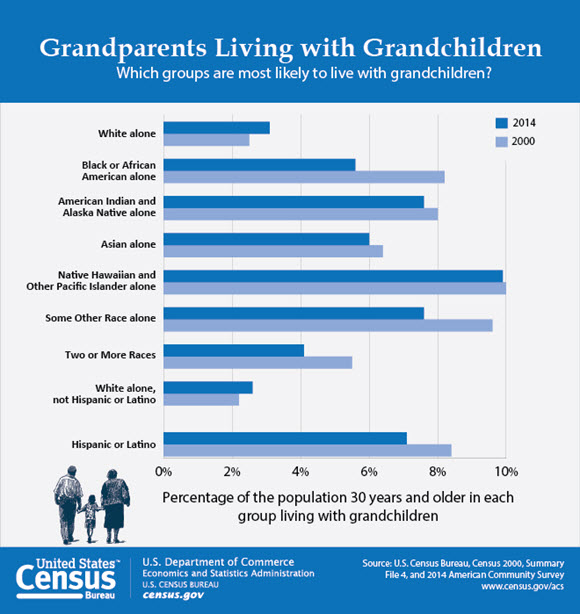
An official website of the United States government
Here’s how you know
Official websites use .gov
A .gov website belongs to an official government organization in the United States.
Secure .gov websites use HTTPS
A lock (
) or https:// means you’ve safely connected to the .gov website. Share sensitive information only on official, secure websites.
-
//
- Census.gov /
- Random Samplings /
- Grandparents and Grandchildren
Grandparents and Grandchildren
Grandparents and Grandchildren
Statistics from the American Community Survey provide information on grandparents living with their grandchildren, including those who have primary care of them. These statistics help [PDF <1.0 MB]federal, state and local program managers understand the needs of this group and design programs for both generations.
Are there more grandparents who live with their grandchildren now than in 2000?
The percentage of the population 30 years and older living with grandchildren has increased from 3.6 percent in 2000 to 3.8 percent in 2014.
A variety of factors may be contributing to this increase. For example, recent immigrants are more likely to live in extended family households. Births outside of marriage are associated with a mother and child more likely to live with the mother’s parent(s). Economic need leads parents to leave a child with a grandparent while they travel for work, and some race/ethnic groups are more likely to live in multigenerational households.
Is there a difference among racial and ethnic groups?
Non-Hispanic whites are the least likely to live under the same roof as their grandchildren (2.6%), an increase from 2.2% in 2000. The largest drop happened among blacks, who saw a decline from 8.2 percent in 2000 to 5.6 percent in 2014.
Native Hawaiians and Other Pacific Islanders were most likely to live with grandchildren in 2014 (9.9 percent), followed by American Indians and Alaska Natives and people of Some Other Race (both at 7.6 percent), Hispanics (7.1 percent) and Asians (6.0 percent).
Are grandparents the primary caregivers?
Not necessarily and, in fact, the percentage responsible for their grandchildren dropped during the same period, from 42.0 percent in 2000 to 36.4 percent in 2014. There was no change in the percentage of grandparents responsible for grandchildren where the grandchild’s parents were not living in the household, which remained stable at about 34.0 percent.
Since 2000, there has been a drop in grandparents who are their grandchildren’s primary caregivers among most race groups. For instance, the percent of blacks living with grandchildren who were responsible for those grandchildren dropped from 51.7 percent in 2000 to 44.0 percent in 2014.
Comparing race and ethnic groups in 2014, American Indian and Alaska Native grandparents who live with grandchildren were most likely to be responsible for raising them (51.1 percent). Asians were least likely (14.8 percent).
The U.S. Census Bureau began collecting data on grandparents who have primary responsibility for the care of their grandchildren in 1999 during a test for the American Community Survey. The 2000 Census asked about grandparents as caregivers and the questions remain on the American Community Survey today.
Share
 Yes
Yes
 No
NoComments or suggestions?


Top

